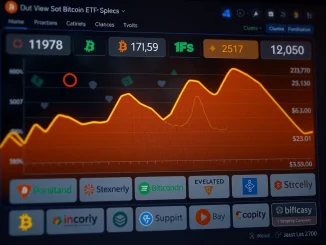
Are you interested in the future of money and America’s place in the global financial system? The conversation around digital assets and their potential to reshape finance is gaining serious traction in Washington. A key voice from the White House is now publicly backing legislation aimed at ensuring the United States stays ahead of the curve.
Understanding the GENIUS Act and Its Goals
Bo Hines, the Executive Director of the President’s Council of Advisers for Digital Assets, recently voiced strong support for the GENIUS Act on social media. According to Hines, this proposed legislation is designed to modernize the U.S. financial infrastructure, positioning the nation for leadership in the evolving digital economy. While specific details of the GENIUS Act might be emerging, its stated purpose centers on fostering an environment where digital assets can thrive under clear regulatory frameworks.
The core idea behind the GENIUS Act, as highlighted by Hines, is recognizing that the traditional financial system needs an upgrade. Digital technologies offer pathways to greater efficiency, accessibility, and innovation. By proactively addressing how digital assets fit into the existing legal and economic structures, the U.S. aims to build a foundation for future growth and maintain its competitive edge on the world stage.
How Stablecoins Can Enhance Dollar Dominance
A significant part of the GENIUS Act’s potential impact, according to proponents like Hines, lies in the strategic use of stablecoins. These cryptocurrencies are designed to maintain a stable value, often pegged to a fiat currency like the U.S. dollar. Unlike volatile assets such as Bitcoin or Ethereum, their stability makes them potentially useful for everyday transactions, remittances, and international trade.
Hines argues that stablecoins can play a crucial role in enhancing dollar dominance globally. Here’s how:
- Digital Accessibility: Stablecoins allow the U.S. dollar’s stability and widespread acceptance to be extended into the digital realm, making it easier and faster for people around the world to hold and transact in a dollar-pegged asset.
- Infrastructure Development: Encouraging the development and adoption of dollar-backed stablecoins builds digital infrastructure that reinforces the dollar’s position in cross-border payments and decentralized finance (DeFi).
- Competition with Other Currencies: As other nations explore central bank digital currencies (CBDCs), a robust ecosystem of dollar-backed stablecoins provides a market-driven alternative that can help the dollar retain its status as the world’s primary reserve currency.
Think of it this way: if conducting transactions using digital dollars (via stablecoins) becomes significantly more efficient than using other currencies’ digital equivalents or traditional methods, global users will naturally gravitate towards the dollar ecosystem. This reinforces the dollar’s utility and demand worldwide.
Improving Payment Systems with Digital Assets
Beyond just enhancing dollar dominance, the adoption facilitated by initiatives like the GENIUS Act can lead to tangible improvements in payment systems. Hines specifically pointed out several key benefits that digital assets, particularly stablecoins, can bring:
- Faster Transactions: Traditional payment systems, especially for cross-border transfers, can be slow, often taking days to settle. Digital asset transactions can settle in minutes or seconds, enabling near real-time value transfer.
- Cheaper Costs: Intermediaries in traditional finance add costs through fees. Digital asset transactions can significantly reduce or even eliminate many of these fees, making payments more affordable, especially for small businesses and individuals sending remittances.
- More Transparency: Transactions on public blockchains, while potentially pseudonymous, are often more transparent in their movement and settlement compared to opaque correspondent banking networks. This can help reduce errors and increase accountability.
Consider the impact on international trade or remittances. A small business importing goods might face delays and high fees sending payments. An individual sending money home to family could lose a significant percentage to transfer costs. Digital assets offer a path to dramatically improve these processes, making global commerce and personal finance more efficient and equitable.
Why US Financial Leadership is Crucial Now
The digital asset space is evolving rapidly, with countries worldwide exploring cryptocurrencies, blockchain technology, and digital currencies. Hines’s emphasis on US financial leadership underscores the critical juncture the nation faces. If the U.S. does not actively engage with and shape the future of digital finance, it risks falling behind.
Leadership in this space involves several dimensions:
- Regulatory Clarity: Establishing clear, predictable rules for digital assets encourages innovation while protecting consumers and financial stability. Uncertainty can drive businesses and talent to other jurisdictions.
- Technological Innovation: Fostering research and development in blockchain and digital asset technologies ensures the U.S. remains at the forefront of building the next generation of financial infrastructure.
- Global Standards: Playing a leading role in international discussions and standard-setting bodies for digital finance ensures U.S. interests and values are reflected in the global landscape.
The GENIUS Act, as described by Hines, appears to be a legislative effort to address these points proactively. By creating a framework that supports stablecoins and other digital assets, the U.S. can attract investment, foster job creation, and maintain its influence in global finance.
Challenges and the Path Forward
While the potential benefits highlighted by proponents of the GENIUS Act are significant, the path forward is not without challenges. Regulatory debates around stablecoin reserves, consumer protection, anti-money laundering (AML), and combating the financing of terrorism (CFT) are ongoing. Integrating digital assets into the existing complex financial system requires careful consideration and collaboration between policymakers, regulators, and industry participants.
The conversation initiated by figures like Bo Hines and the push for legislation like the GENIUS Act signal a growing recognition within U.S. policy circles that ignoring digital assets is not an option. Instead, the focus is shifting towards understanding how these technologies can be leveraged to strengthen the U.S. economy and maintain its global financial standing.
Key Takeaways:
- White House adviser Bo Hines supports the GENIUS Act for modernizing U.S. finance.
- Stablecoins are seen as a tool to enhance dollar dominance and improve payments.
- Benefits include faster, cheaper, and more transparent transactions.
- The U.S. aims to lead in the next generation of digital finance.
- Legislation like the GENIUS Act is crucial for providing regulatory clarity and fostering innovation.
Conclusion: A New Era for US Finance?
The endorsement of the GENIUS Act by a White House adviser underscores a strategic pivot within U.S. policy towards embracing digital assets. By recognizing the potential of stablecoins to bolster dollar dominance and improve payment systems, and by aiming to secure US financial leadership in the realm of digital assets, the U.S. is taking steps to navigate the future of finance. While challenges remain, the focus on proactive legislation like the GENIUS Act suggests a commitment to building a digital financial infrastructure that is efficient, competitive, and maintains America’s prominent role in the global economy. This is a developing story, and the progress of the GENIUS Act and similar initiatives will be critical to watch for anyone invested in the future of finance.



